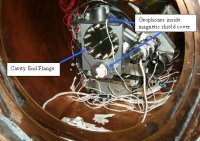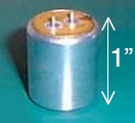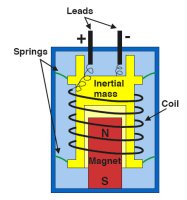 |
 |
|||||||||||||
|
|||||||||||||
|
|||||||||||||
|
Vibrations in the cryomodules in the International Linear Collider are actually not a good thing. The slightest disruption can throw off the alignment of the super sensitive beams and prevent them from colliding. The stringent beam dynamic requirements in the ILC therefore make vibration studies important, which is why Fermilab recently installed measuring devices called geophones in their Horizontal Test Stand. So for the team at Fermilab, detecting vibrations now, during an R&D phase, is actually a good thing because it means that they can learn how to minimise them in the actual machine when every collision counts.
For the ILC, the sensors used to measure vibrations in the cryomodules must meet two requirements: operate with extreme sensitivity at low frequencies and maintain that sensitivity in a cold environment. “That is the challenge,” says Fermilab's Ruben Carcagno. “Most devices lose their low frequency sensitivity in a cryogenic environment.” Faced with a challenge, scientists at DESY are the ones who first installed commercially available room temperature geophones in a cryomodule for FLASH, and successfully tested them in a cryogenic environment (see ILC NewsLine, 22 March 2007). Measuring roughly one inch in height, each sensor consists of a sensing coil suspended by a spring in an axial magnetic field provided by a small permanent magnet. When shaken, the coil moves and interacts with the magnetic field, generating a voltage that scientists can use to calculate the displacement resulting from vibrations. “The total vertical displacement that results on the quadrupole magnet inside the cryomodule is exactly what you want to detect,” says Carcagno. As an added bonus, each commercially available geophone costs less than 50 dollars, and each cryomodule needs a few sensors, so vibration studies will not break the R&D budget bank. Vibrations can result from several sources inside and outside the cryomodule. Ground motion is one source. The cryogenic system is another. Just running fluids to cool the cryomodule or noise from pumping equipment nearby or even the radiofrequency pulse inside the superconducting cavities can cause vibrations. While the teams at DESY and Fermilab can't eliminate these disturbances, they can use the data to evaluate the design and ultimately determine how to build the optimal cryomodule. “Vibration sources cannot be completely eliminated,” says Carcagno. “The feedback that we get from geophones is useful to understand how to mitigate the effect of these vibration sources on critical cryomodule components such as the quadrupole.” If the team can understand how the cryogenic system causes vibrations, for instance, they can work with the cryogenic engineers to tweak and optimise the design. The same philosophy is true for the quadrupole magnet and even the overall design of the cryomodule. Because the geophones are used for optimising the design, they will not be part of the actual cryomodules in the ILC --- just the cryomodules that are used for R&D purposes. “We are essentially monitoring vibrations to see how to design the best cryomodule,” Carcagno says. Installing geophones in the Horizontal Test Stand, a cryostat that mimics the conditions in the ILC, allows the team to test the actual sensors and calibrate the overall system before using it in a full-sized cryomodule. In addition, the Fermilab team installed magnetically shielded geophones on the cavity itself for the first time to study vibrations for cavity resonance control purposes. “We are perfecting the system so that when we install them in the cryomodule, we will have a system that works,” says Carcagno. The Fermilab team will have that chance soon as they start to assemble a “cryomodule kit” courtesy of DESY. Complete with instructions and all, this kit will be the first cryomodule that Fermilab builds. Under the watchful eye of DESY scientists, the exercise serves two purposes: constructing the first cryomodule at Fermilab and finding out how well the instructions work. The vibrations team plans to install their geophones in late September, when the major cryomodule assembly work will happen. They will begin to collect data when the completed cryomodule moves into the ILC Test Area - New Muon Laboratory later this fall. -- Elizabeth Clements |
|||||||||||||
| © International Linear Collider |


